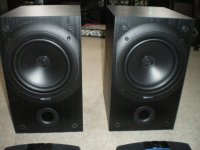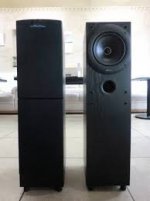Hi all
A question: The Kef Q30 and Q10 are very similar apart from the size of the cabinet. The Q30's have a void directly beneath the bass speaker which is empty and is cut off from any sound by having a piece of chipboard (or whatever the cabinets are made from) directly underneath the reflex port. I have uploaded pics.
What is the purpose of this extra cut off space in the Q30's? being an empty void and cut off from any sound waves, would this make any difference compared to the Q10's? or is it just to make the Q30's stand taller? would resonance play some part?
I'm baffled!!
Phil
A question: The Kef Q30 and Q10 are very similar apart from the size of the cabinet. The Q30's have a void directly beneath the bass speaker which is empty and is cut off from any sound by having a piece of chipboard (or whatever the cabinets are made from) directly underneath the reflex port. I have uploaded pics.
What is the purpose of this extra cut off space in the Q30's? being an empty void and cut off from any sound waves, would this make any difference compared to the Q10's? or is it just to make the Q30's stand taller? would resonance play some part?
I'm baffled!!
Phil
Attachments
Often a floorstanding loudspeaker would be required in a product range. Typically these want to be x cms tall to get the tweeter to around ear height when seated. If the driver doesn't need all of the volume that a cabinet of this size would offer, then a shelf would be put in to reduce the volume that the driver sees.
6.5" drivers can be engineered to work very well in 25-30 litre cabinets of this size though, optimising the driver to make full use of it would be the best thing to do, but if cost constraints wont allow that, then you have no choice.
6.5" drivers can be engineered to work very well in 25-30 litre cabinets of this size though, optimising the driver to make full use of it would be the best thing to do, but if cost constraints wont allow that, then you have no choice.
Often a floorstanding loudspeaker would be required in a product range. Typically these want to be x cms tall to get the tweeter to around ear height when seated. If the driver doesn't need all of the volume that a cabinet of this size would offer, then a shelf would be put in to reduce the volume that the driver sees.
6.5" drivers can be engineered to work very well in 25-30 litre cabinets of this size though, optimising the driver to make full use of it would be the best thing to do, but if cost constraints wont allow that, then you have no choice.
Yes, that's my point the Q30's don't utilize the full size of the cabinet as it is blocked off!
Imagine a piece of wood (HORIZONTAL) fitted inside the cabinet of the Q30'S directly below the reflex port. No sound can get through so back to my original question: what is the purpose? to make it at ear height? Wonder what would be the consequence if I was to knock out this piece of wood?
I answered the point of its purpose in my other reply. The driver cannot work well in the volume that the full cabinet would provide, hence the shelf. If you remove it you will significantly alter the cabinet alignment and as these are Kefs and their engineers tend to get things right, most likely for the worst.
If you want to see if the driver would work well in a bigger box then you really need to measure the T/S parameters of the driver.
Also if the driver could be made to work well in a larger cabinet, for greater overall bass extension, then I would have expected Kef to have done this in the first place.
If you want to see if the driver would work well in a bigger box then you really need to measure the T/S parameters of the driver.
Also if the driver could be made to work well in a larger cabinet, for greater overall bass extension, then I would have expected Kef to have done this in the first place.
The driver cannot work well in the volume that the full cabinet would provide, hence the shelf.
So the shelf is there just to provide height?
The drivers are the same for both speakers,same bass speaker, same tweeter, same crossover, as apparent on their own website: Explore KEF - Q10, Q30, Q50, Q70 - KEF International
Yet they state that the Q30 is 10-125 watts for the Q30 compared to 100 watts for the Q10 and the frequency response for the Q30 is 50 - 20kHZ compared to 60 - 20 kHZ for the Q10.
How can this make a difference? The speakers are theoretically the same!
So the shelf is there just to provide height?
The drivers are the same for both speakers,same bass speaker, same tweeter, same crossover, as apparent on their own website: Explore KEF - Q10, Q30, Q50, Q70 - KEF International
Yet they state that the Q30 is 10-125 watts for the Q30 compared to 100 watts for the Q10 and the frequency response for the Q30 is 50 - 20kHZ compared to 60 - 20 kHZ for the Q10.
How can this make a difference? The speakers are theoretically the same!
"What is the purpose of this extra cut off space in the Q30's?" They were giving you a significant performance enhancement opportunity - but put it right under your nose. That cu-in of space can hold about 30-35 lbs of sand. Turn the speakers over, take off the bottom plate and cut 1.5" hole in the bottom. Fill 'er up with your favorite play or beach sand, put the cutout plug back in and seal with duct tape. Put a couple of cut out cardboard pieces between the bottom plate and the taped over plug. Turn it over and note how the carpet spikes punch all the way down through the carpet on their own now. Given the business end of the speaker now has ~35 lbs to "push against", this should show up as a positive in how it sounds.
I know, probably a little late, but I just picked up a working-well pair at a yard sale for $20. I got rid of KEF's insistence on the use of aluminum electrolytics in the crossover, at least in the tweeter circuit. Got the sand in one, still working on the other (the sand is wet...)
OK I have a question. In the crossover, KEF used a branded capacitor (7 uF Bennic) looking into the inductor, but then use their stock alum-el at 16 uf going to the tweeter. What does this second capacitor do? Why is it different in value than the branded one?
I'm looking for something like "The value of the second capacitor doesnt matter - as long as it's at least 7uf to match the first. They just used a stock 16 to save on production costs for outfitting with a second Bennic".
I know, probably a little late, but I just picked up a working-well pair at a yard sale for $20. I got rid of KEF's insistence on the use of aluminum electrolytics in the crossover, at least in the tweeter circuit. Got the sand in one, still working on the other (the sand is wet...)
OK I have a question. In the crossover, KEF used a branded capacitor (7 uF Bennic) looking into the inductor, but then use their stock alum-el at 16 uf going to the tweeter. What does this second capacitor do? Why is it different in value than the branded one?
I'm looking for something like "The value of the second capacitor doesnt matter - as long as it's at least 7uf to match the first. They just used a stock 16 to save on production costs for outfitting with a second Bennic".
Last edited:
- Status
- Not open for further replies.

